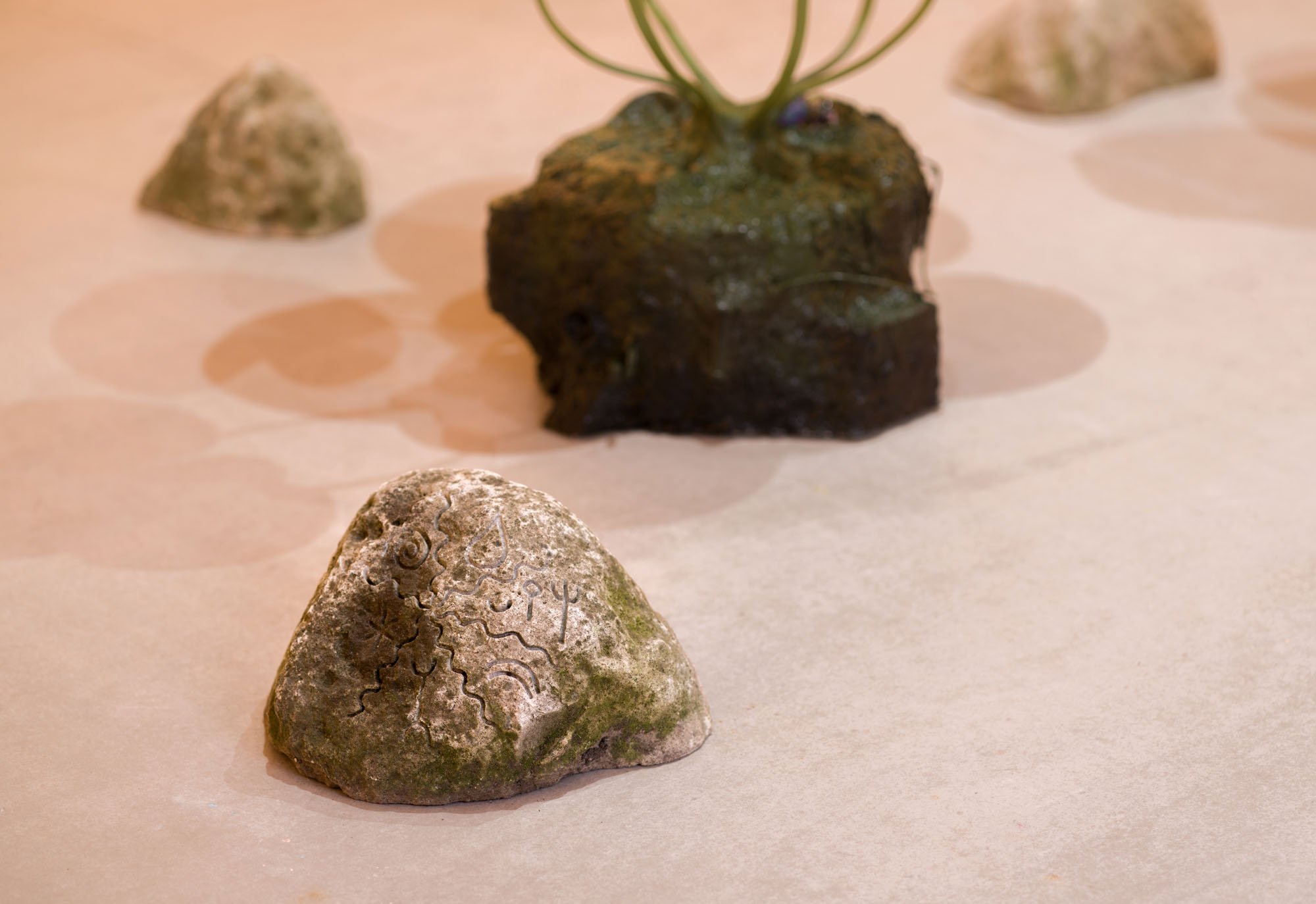21 WADE AVE #2 | TORONTO
CAMILLE JODOIN-ENG | CONVERGENCE AT THE FROG POND | 24 NOV - 23 DEC 2022
“For a mystic, the inner world is a weather that contains the universe and uses it as symbolic language.”¹ The artist, kin to mystic, has a similar relationship to their inner world, using the universe behind the veil to develop their own visual vernacular. For the artist Camille Jodoin-Eng, the terrain of that world, of its feelings and curiosities, is the basis for her growing group of invented symbols. She dips into that world’s depths and out of intuition they emerge: some as simple as an oval or curved line; others, like the papier-mâché pieces on view at Convergence at the Frog Pond, more elaborate. There are experiences that inspire her works—water moving over rocks in a small creek, flocks of birds undulating in the sky, a friend putting on their makeup—but these exist more like spiritual references for the abstract forms they're related to. Her symbols, born from a wordless place, are a mystery even to Jodoin-Eng, and she invites others’ interpretations. I think of what 13th century poet Rumi once wrote: “If the nut of the mystery can’t be held, at least let me touch the shell.”² If the nut of the mystery can’t be held, then at least we all can describe, in our own language, the way the shell feels pressed against our skin. We can also of course speculate what exists beyond. Sharing our respective descriptions and guesses—honouring the multivalence—can lead to the tremendous widening of our inner worlds. For Jodoin-Eng, part of her practice is contemplating the mystery together.
Convergence at the Frog Pond is also inspired by quiet pockets we may find in a forest while on long hikes. It’s difficult in present times, though, to find a spot in nature free from the mark of heedless people—think of the litter often found peppered through fields of perky or flattened grass. I imagine Jodoin-Eng discovering a clearing within the forest, the vestiges of human presence strewn about, and going beyond removal: instead, guided not only by care but creativity, she gathers whatever discarded object— plastic bottles, electrical wiring, industrial spools—and finds a place for them in her art, the lilypad sculpture in Convergence an evocative example. I think of magpies, or bower birds, who cumulate objects made by nature or man to fashion something sublime. What Jodoin-Eng’s art does—and invites her viewers to do—is try, despite pain and destruction, to never forgo the creative impulse. We need it in order to survive.
1 Jalāl Al-Dīn Muḥammad Rūmī. (2004). Selected poems (Maulana, Barks, C., & Moyne, J., Trans.) Penguin.
2 Ibid.
- Rosemary Flutur
Camille Jodoin-Eng is an artist based in Toronto. She has developed a growing visual language of symbols that reveal the intuitive and indefinite. Jodoin-Eng's studio practice combines mirrored structures, light, papier-mâché, discarded trash, glass, paint, and ink drawings. Often inspired by shrines and temples as spaces devoted to reflecting on otherworldly existences, her work engages with symbology to create physical manifestations representative of the internal world.
Jodoin-Eng completed her BFA at OCAD University (2014), and is currently a collaborator of Patel Brown Gallery. Recent exhibitions include Convergence at the Frog Pond at Patel Brown Gallery (2022) Earth Shrine at Patel Gallery (2020), and The Gate at Project Gallery (2018). Jodoin-Eng has received grants from the Ontario Arts Council and the Toronto Arts Council. Jodoin-Eng has exhibited throughout Ontario and Quebec and completed numerous commissioned installations including AGO Massive, SMASH Gardiner, the Gladstone Hotel, The Drake Hotel, and the W Hotel.
Rosemary Flutur is a writer living in Tiohtià:ke/Mooniyang/Montréal.
Created with the generous support of the Toronto Arts Council and Ontario Arts Council.










